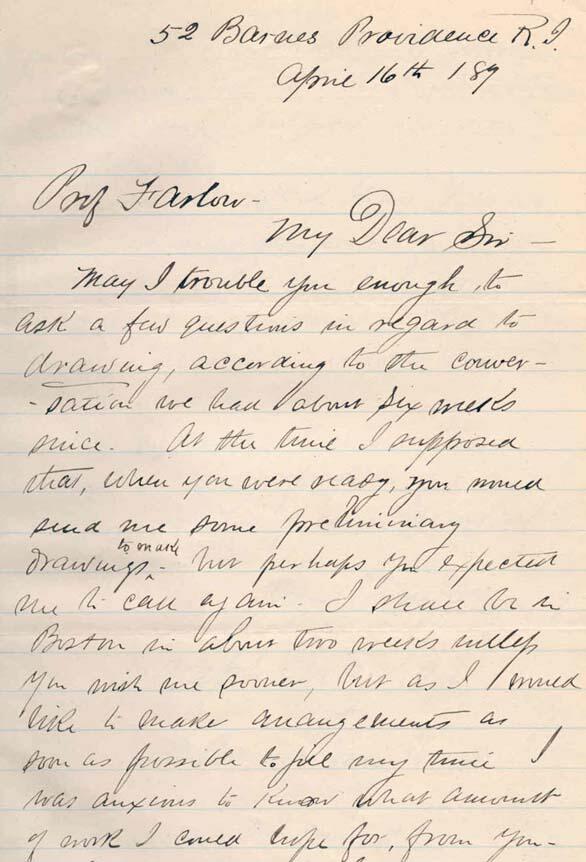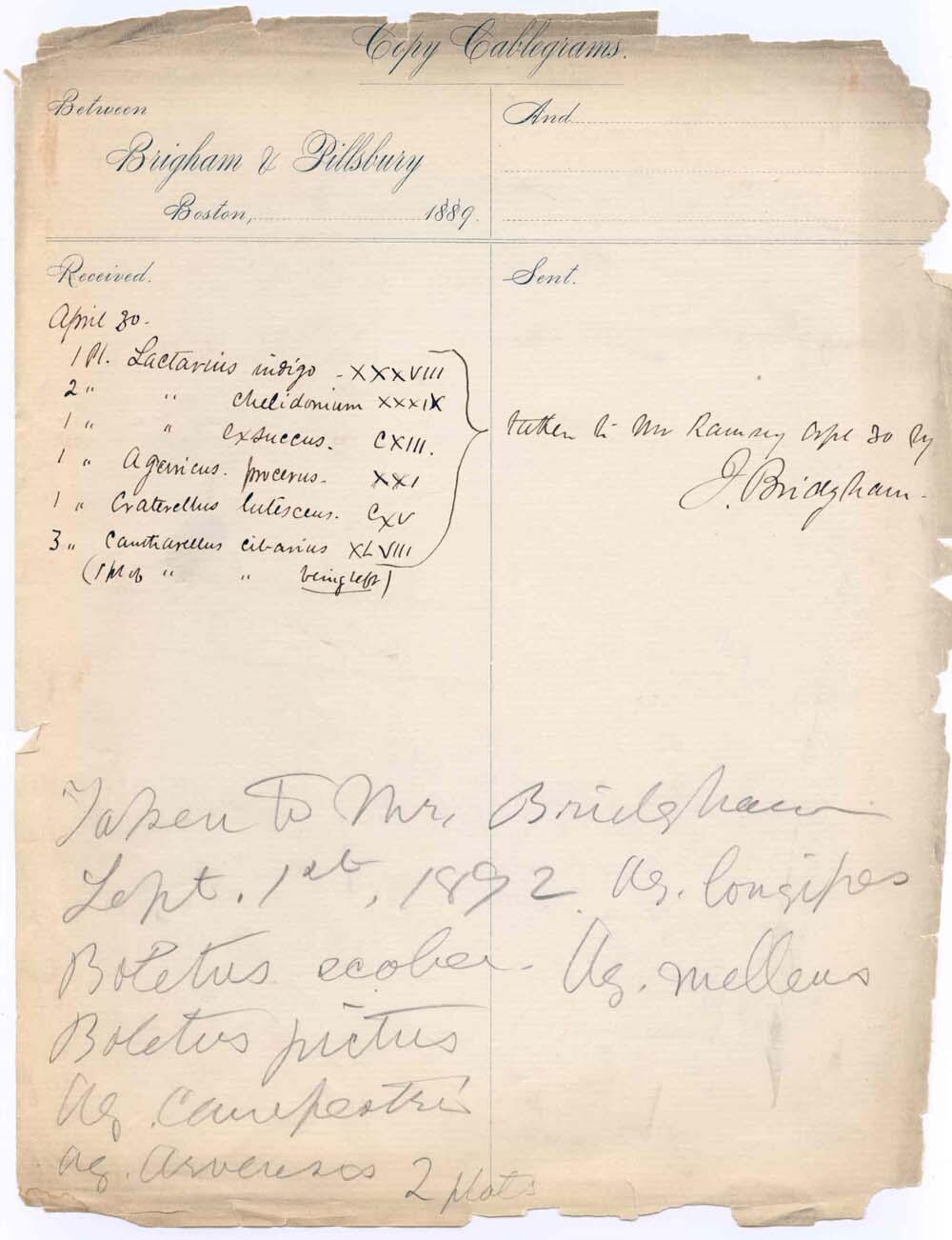In the 1870s when William Gilson Farlow was studying under Asa Gray at Harvard, there were no facilities in America for the study of cryptogams. Farlow traveled to Europe to study under leading scientists and return to share what he had learned. This drive to acquire knowledge and to share it with others seems a common theme in Farlow's life. He was a fascinating and inspiring teacher known for being helpful to all his students. G.P. Clinton (1867-1937) writes, "...but even more important than his lectures was his work with students in research. Here his inspiring personal teaching - for he never left them to an assistant - developed many distinguished students." [1] This drive to help others learn is seen again in the concept of Farlow's Icones.
In his introduction to Icones Farlowianae, Farlow explained that he hoped the book would allow more people access to the study of fungi.
- One of the aims of the author in preparing the present work has been to furnish to those who are not in the possession of large libraries and collections the means of identifying the more striking and characteristic of our larger fungi [2].
Unfortunately the other aspects of this work are not as easy to trace as Farlow's purpose. His initial conception of the project is much more difficult to pinpoint. Farlow did not record the date he decided a book of the larger fungi of New England was needed, nor did he mention in any correspondence when he began to collect materials for this book. However, using specimens, correspondence, notes, drawings, and ephemera that was left behind, it is possible to estimate when Farlow's idea became a reality.
The real work on the book appears to have begun in the mid to late 1880's. This seems a reasonable estimate for two reasons. First, Farlow's earliest notes regarding types of fungi that appear in the Icones date from the mid-1880s. Second, in early March of 1889 Farlow met Joseph Bridgham of Providence, Rhode Island. Bridgham was a natural history artist of some renown and an entomologist with a special interest in lepidoptery. It is unclear how they met although it might have been through Alexander Agassiz (1835-1910) or Professor Samuel Henshaw (1852-1941), both of Harvard's Museum of Comparative Zoology, who Bridgham also drew for [3]. At their meeting Farlow discussed his need for an artist to create drawings of specimens for him. Bridgham wrote to Farlow on April 16, 1889, asking about the work they had discussed.

Professor Farlow
May I trouble you enough to ask a few questions in regard to drawing, according to the conversation we had about 6 weeks since. At the time I supposed that, when you were ready, you would send me some preliminary drawings to make but perhaps you expected me to call again. I shall be in Boston in about two weeks unless you wish me sooner, but as I would like to make arrangements as soon as possible to fill my time, I was anxious to know what amount of work I could look for from you [4].
Bridgham and Farlow came to an agreement and in a letter dated June 11, 1889, Bridgham discusses his salary for the work he is doing for the museum, probably the Museum of Comparative Zoology. He states "I have made the price $5.50 per day - which is almost 75 cents per hour for a day of 7 1/2 hours. My agreement with you for [work] is somewhat under that rate." [5] Whatever the exact rate, Farlow and Bridgham agreed it was fair and work was begun. Beginning in August 1889, Farlow began to make periodic trips to Providence to drop off specimens and review drawings in progress.
Farlow assembled as much information as possible for Bridgham, and later his second artist L.C.C. Krieger, with a detailed account of the fungus. Pictures were made of the fresh specimens and copious notes were collected regarding color, size, characteristics, and habitat. If possible Farlow also provided spore prints, a print of the gill pattern of a mushroom made by placing the mushroom cap on a small piece of card stock and allowing it to sit so that the spores fall out and mark the card.
 Farlow also kept very detailed notes as to which items Bridgham was working on and which had been completed. It was quite a lot to keep track of considering that Bridgham drew over 303 different fungi during the 10 years that he drew for Farlow.
Farlow also kept very detailed notes as to which items Bridgham was working on and which had been completed. It was quite a lot to keep track of considering that Bridgham drew over 303 different fungi during the 10 years that he drew for Farlow.
 Each time Bridgham took possession of new materials to make a drawing, Farlow drew up a dated receipt (the image to the left), for Bridgham to sign. Farlow also kept track of the work in notebook (the image to the right ) where he marked down exactly what images were to be done, in progress, and completed[6]
Each time Bridgham took possession of new materials to make a drawing, Farlow drew up a dated receipt (the image to the left), for Bridgham to sign. Farlow also kept track of the work in notebook (the image to the right ) where he marked down exactly what images were to be done, in progress, and completed[6]
Farlow's next step was to find a printer. In his correspondence with Nathaniel Britton (1859-1934), of the New York Botanical Garden, he discusses his problems in finding someone suitable. In a letter dated July 30, 1889 Farlow tells Britton that he has to go to Providence to visit his artist because, while the drawings are good the engravings made from them are very poor [7]. He goes even farther in a letter dated January 17, [1891] stating "Printers are dreadful. Some are nominally cheaper than others, but, if accuracy in setting up scientific papers is needed, the extra corrections make the cheaper men nearly as dear as the more expensive and the result is, on the whole, not a success. At least, my own attempts at economy in printing have been expensive and sometimes mortifying. I am now ready to pay more to a man close at hand and practically under my thumb, which means someone whom I can scold and bully." [8] Farlow was most likely referring to the Boston Heliotype Printing Company, the company that he hired to print up the final plates.